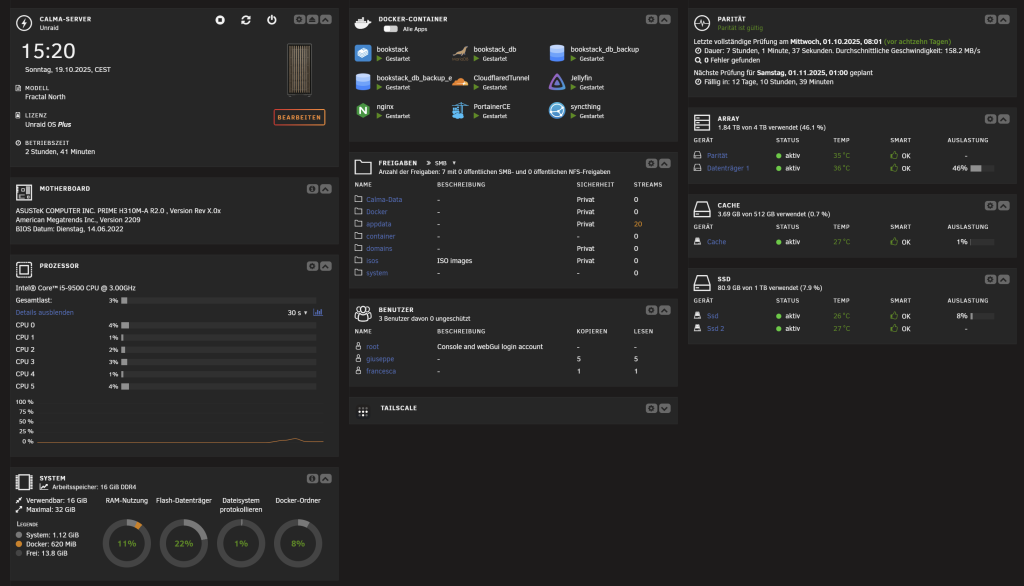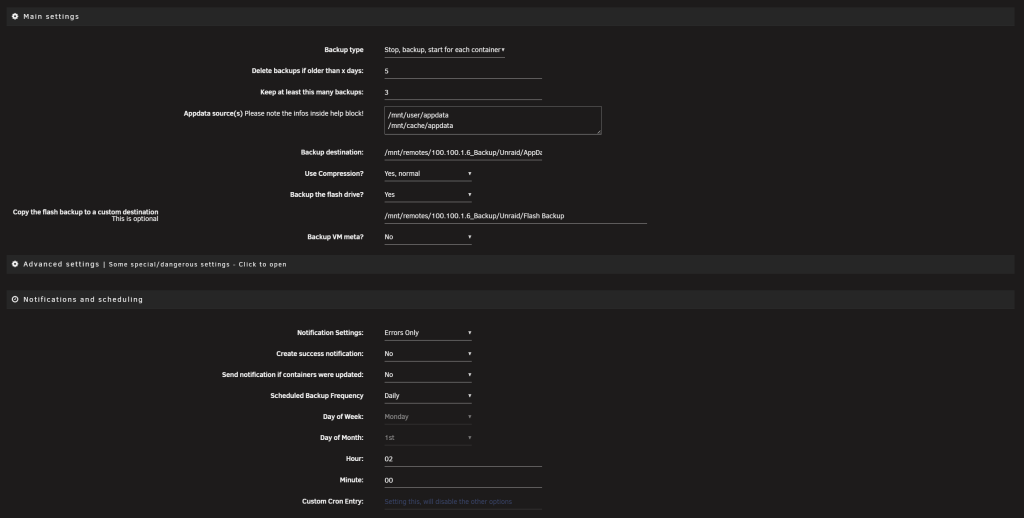Since April 2024, I’ve been running my own Unraid server. It primarily serves as my external storage solution and hosts several self-hosted services, including Syncthing, BookStack, and Jellyfin.

I bought an Unraid Plus license before the new pricing model was introduced in June 2024. With this license, I get lifetime OS updates and the ability to connect up to 12 storage devices.
For the system itself, I refurbished an old workstation PC and upgraded it with a few new components to give it a second life.
My components:
| Component | Price (€) |
|---|---|
| Unraid Plus | 85,00 |
| Mainboard: ASUS PRIME H310M-A R2.0 | 0,00 |
| CPU: Intel Core i5-9500 | 0,00 |
| RAM: 2x Samsung DDR4 2600MHz | 0,00 |
| Cooling: be quiet! Pure Rock 3 Black | 34,90 |
| Power: be quiet! SFX POWER 3 300W | 53,03 |
| Case: Fractal Design North White | 146,35 |
| USB-Stick 8GB USB 2.0 | 4,04 |
| 1x Samsung 5120GB NVMe | 0,00 |
| 2x 1TB SSD Intenso System drives | 113,98 |
| 2x 4TB HDD Seagate Storage drives | 207,98 |
| Additional 2.5-GBit network card | 21,99 |
| Sata Cables | 5,49 |
| Total | 672,76 |
| Subtotal (without drives) | 350,80 |
For my disk configuration, I set up three main storage groups: a Data array, a System, Domains & Docker pool, and a Cache pool.

I also attached an SMB share using the Unassigned Devices plugin, which serves as a remote backup target through the Appdata Backup plugin.
For secure remote access to my Unraid server, I installed the Tailscale plugin. It allows me to connect to my server from anywhere without exposing any ports to the internet, and also provides a secure link to my remote backup server.
External Backup
As mantioned i’m using the Appdata Backup plugin for the Appdata and To keep my system safe, I decided to set up regular backups of my flash drive and appdata. For this, I’m using the Appdata Backup plugin, which can be easily installed through the Unraid App Store or directly from GitHub: https://github.com/Commifreak/unraid-appdata.backup

In my case, I configured it to back up to a remote location. To achieve this, I combined the Appdata Backup plugin with the Unassigned Devices plugin — available here: https://github.com
The Unassigned Devices plugin allows me to mount and use an external SMB share as the backup destination. To securely connect my Unraid server to this remote storage, I’m using the Tailscale plugin. It creates a private, encrypted network between my devices, so I can safely reach my backup server without exposing any ports to the internet.
If you’d like to set up Tailscale yourself, the official Unraid documentation provides a clear step-by-step guide: https://docs.unraid.net/unraid-os/system-administration
Adding a 2.5-GBit network card
After upgrading my home network to 2.5 Gbit, I decided to also upgrade my Unraid server to take full advantage of the increased speed. The onboard network interface on my motherboard only supported 1 Gbit, which quickly became the bottleneck when transferring larger files.
To solve this, I installed a 2.5 Gbit PCIe network card. The upgrade was plug-and-play — Unraid detected the new card right away without any additional drivers or configuration.
In the network settings, I configured the new 2.5-Gbit adapter as eth0, making it the primary network interface. The original onboard 1-Gbit connection was reassigned as eth1 and now serves as a backup link, ensuring that I still have local access to the system in case something goes wrong with the main interface.

Overall, this small and inexpensive upgrade made a big improvement in everyday performance and responsiveness across my entire network setup.

Leave a Reply